Historian and CovSoc Committee member, David Fry, has been studying past editions of the Alfred Herbert Newsletter. These newsletters are much more than just a works newsletter and reveal a lot about the thinking in the city at the time they were written. The article below is extracted from 1956 editions of their Newsletter, looking back at a year of activity in the busy post-war city, and is written in the words of the Alfred Herbert’s employee. David writes….
The scene is set for all the changes to the city centre we now take for granted but viewed in the context of national and international events…
The new year of 1948 was ushered in with the following caustic press comment; “No-one will regret the passing of 1947, a year of bitter disappointment and disillusionment”.
It had certainly left much to be desired in every way and few things seemed to be working out the way they should. Nevertheless the Government continued with its policy of nationalisation and on January 1st, all the railways passed into State control.
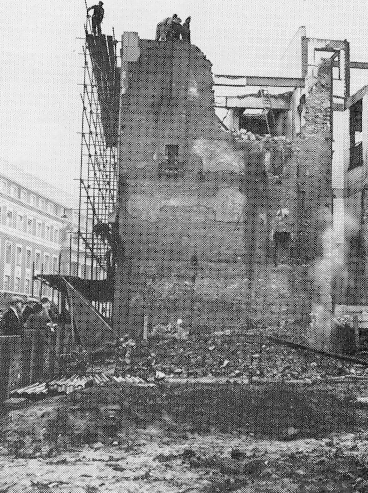
In Coventry the knell of doom for ancient Smithford Street was sounded when it was closed to vehicular traffic so that the necessary demolitions could take place for the rebuilding of Broadgate ; while from abroad there came “a blast of vituperation such as the Kremlin regularly emits”.
And still confidence and fear walked hand in hand.
Confidence was expressed in Coventry by the preparations for rebuilding and re-beautifying the city as instanced by the clearing and returfing of the Cathedral site.
Fear by Sir Stafford Cripps who, speaking of the economic plight of the country, said, “The gravity of the situation cannot be exaggerated”. A cut of 40% in the allocation of steel to manufacturers, which almost immediately faced 300 employees of the Armstrong Siddeley Motors with dismissal, proved the truth of Sir Stafford’s dismal utterance.
On February 4th, a pleasing announcement was made in the local press.
Four firms, Sir W. G. Armstrong Whitworth Aircraft Ltd., Motor Panels (Coventry) Ltd, Holbrooks (Coventry) Ltd. and John Astley and Sons Ltd., made a combined gesture to the city. As a monument to the skill of Coventry’s craftsmen, they made a gift to the city of the City Standard, an aluminium mast 56 feet high bearing the City Arms and surmounted by an elephant which was to be erected in Broadgate, at the top of the proposed new Precinct.
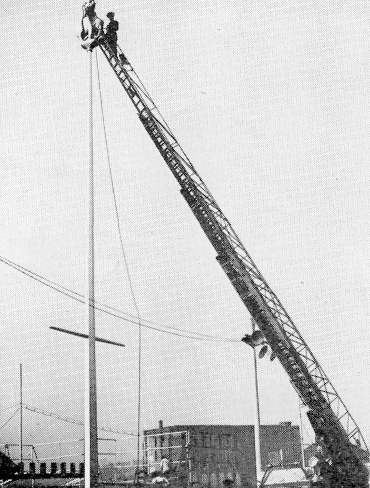
And now it seemed that 1948 was to repeat the pattern of 1947, “the year of bitter disillusionment”.
The end of February saw 18,000 Yorkshire miners out on strike, while the beginning of March saw Coventry’s transport brought almost to a standstill for nearly three weeks by a strike of the maintenance staff.
Again, a ray of confidence as Lord Kenilworth, with a magnificent gesture, donated, £100,000 to the Cathedral Re-building Fund.
On April 1st all electric supply undertakings were taken over by the Government as it relentlessly pursued its avowed policy of nationalisation. Many people were already doubting the wisdom of this policy seeing that the promised coal harvest which would be gathered under nationalisation had proved a mirage.
Again the disruptive and suicidal effects of strikes were felt. On April 5th, 6,000 London dockers went on strike to be followed a fortnight later by 8,500 Yorkshire miners. That the A.E.C. had made an offer, later to be accepted, to absorb the Maudslay Motor Company, an old Coventry firm established in 1907, was hardly of sufficient importance to cause an extra ripple on the already turbulent waters of events.
Nevertheless on April 20th came news that was to act as oil on those troubled waters. America passed the stupendous Marshall Aid Plan whereby millions of dollars were to be poured into war-torn Europe in an endeavour to stabilize tottering economies.
Was it a coincidence that almost immediately after this magnificent gesture the humble potato was no longer rationed?
For the moment, however, Coventry was neither concerned about Marshall Aid nor yet potatoes, for another Royal visit, so beloved of the citizens, was impending.
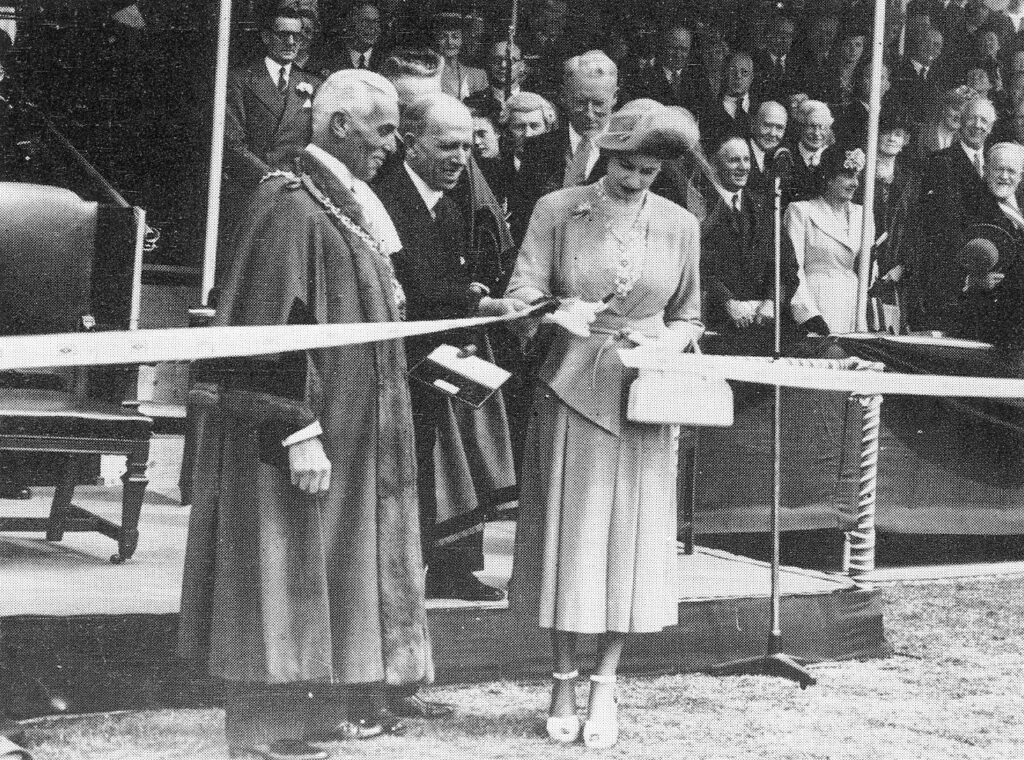
On May 22nd H.R.H. Princess Elizabeth paid her first visit to Coventry for the purpose of declaring open the new Broadgate and laying the foundation stone of that great new shopping concept, the Precinct.
Arriving at the station at 10.59 a.m. in perfect summer weather, Her Royal Highness, after inspecting the guard of honour, drove through densely packed, cheering crowds to the Memorial Park. Here, amid yet more densely packed crowds, various guests were presented to her, after which she took the salute of various Coventry organisations.
The Princess then inspected an imposing exhibition of the city’s industrial products, after which she drove to St. Mary’s Hall for a civic luncheon.
After lunch, she drove to Broadgate where, in a setting that almost resembled an ancient Roman arena, so tightly were the crowds packed round the island, the Princess, looking a picture of radiant youth and happiness, declared Broadgate open.
Again Baron Bentinck van Schoonheter was present but this time he had the satisfaction of seeing the flowering shrubs and plants, so generously given by the people of the Netherlands, in the setting for which they had originally been sent. Broadgate island, under the summer sun was a riotous blaze of magnificent colour, a fitting setting for the Royal visit.
After declaring Broadgate open, the Princess then laid the foundation stone of the new Precinct. In her speech she said that she did not want to dwell on the horrors of the war but rather on the beauty that was, and she was sure would continue to emerge, in the new city centre.
After tea in St. Mary’s Hall, Princess Elizabeth boarded the train for London at 5.27 p.m. leaving behind in the minds of thousands of Coventry citizens happy memories of a truly royal occasion.
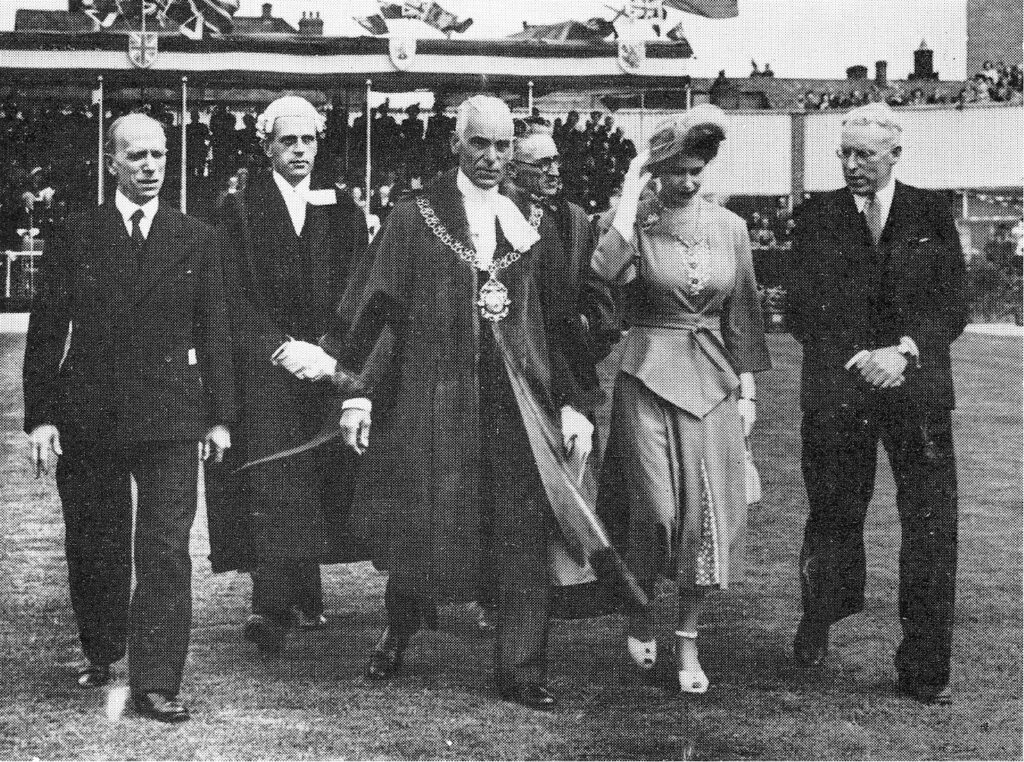
On June 1st, it was announced that the ban on pleasure motoring was to be lifted to the extent of allowing motorists sufficient petrol for driving 30 miles per month. This disappointed many who had been hoping for much better things but, taken with the abolition of potato rationing, did seem to point to a slightly better future.
If it did, it was quickly enshrouded in gloom again, for on June 13th there was another dockers’ strike and by the 19th of the month, 15,000 were idle.
In a very short time, cargoes to the value of £15,000,000 were held up and the country’s food rations gravely jeopardised.
As a result, on the 23rd, troops were called in to unload ships and it was announced that the weekly meat ration would be reduced to 6d worth of corned meat and 6d worth of fresh meat per week.
On the 28th, the strike spread to the Merseyside, but fortunately, two days later, the dockers decided to resume work, only just in time to avert what might well have been the total collapse of the country’s economy.
In the meantime, Coventry, so fortunate in its benefactors, had received yet another munificent gift from a prominent industrialist, for Sir Alfred Herbert and Alfred Herbert Ltd., the firm which he had founded, had entered into a covenant with the Cathedral Rebuilding Fund whereby it was to receive the sum of £25,000 in the next seven years.
On July 1st, the Governors of the Coventry and Warwickshire Hospital met for the last time for, on July 5th, the Hospital, which had been ran on a voluntary basis for 110 years, was formally to be handed over to the Government. On that date, the National Health Service Act became law and the health of the nation became a Government concern.
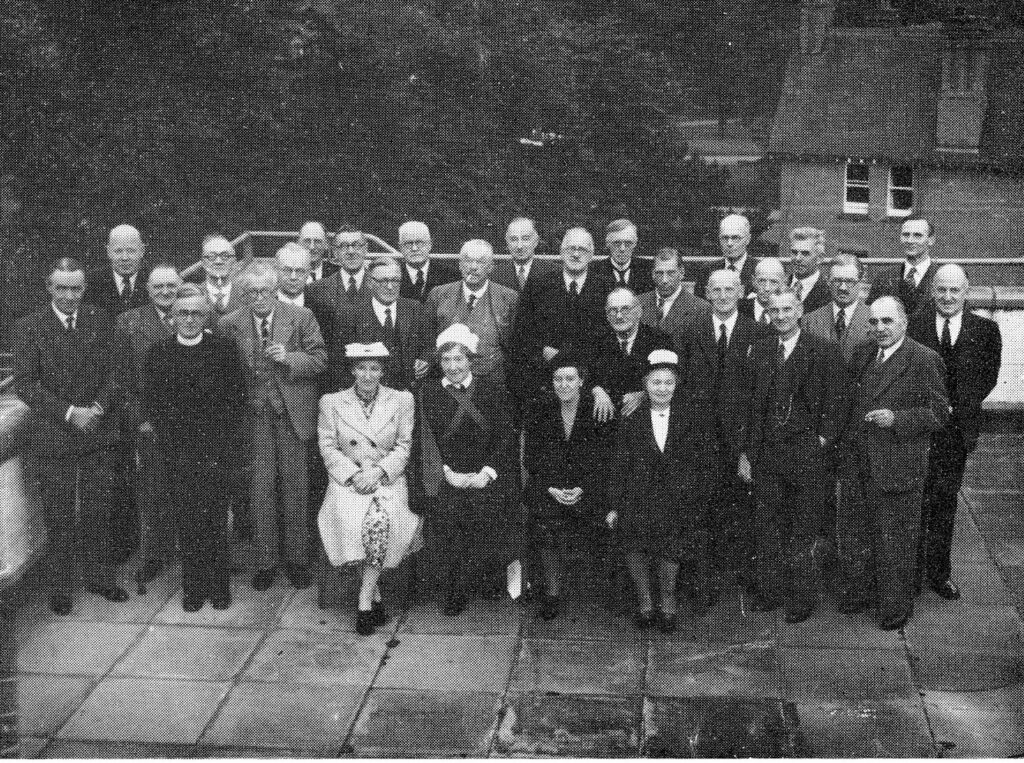
And even as the Government continued to spread its tentacles in various directions, so it withdrew them in others, for on July 21st it was announced that bread rationing would end.
In the meantime, Coventry Corporation was busy buying land around Broadgate to carry on with the rebuilding of the city centre.
It was early in August that the Chancellor of the Exchequer, Sir Stafford Cripps once more emphasised the gravity of the national economic situation. “The threat of collapse still hangs over us”, he said in a letter addressed to 12,000 industrial firms, and he appealed to employers and workers to increase output, sink old differences and pull together towards a common end.
In Coventry where unemployment, particularly in the car industry, was steadily declining, this exhortation did not seem so important as the cigarette famine which had struck the city. Increasing industrial output was marching hand in hand with increasing irritation caused by this inexplicable shortage.
However, both increase and shortage were sharply banished from the foreground of people’s thoughts when, on the night of August 11-12th, torrential rain of tropical density caused the worst floods in the city since the great floods of 1900. Considerable damage was done over a wide area, more particularly in Spon End where the flood water reached a depth of 2 feet.
Even so, things were considerably worse in the north. At Peebles the River Tweed rose six feet in two hours, cities were completely cut off, five bridges were destroyed and hundreds of cattle and horses drowned.
It was indeed fortunate that the floods subsided almost as quickly as they had arisen, otherwise irreparable damage would have been done at a time when the country could least afford it.
On September 3rd the people of Coventry heard with very real regret of the death of Dr Edouard Benes, former President of Czechoslovakia, who had visited the city in March, 1944.
And surely, if slowly, the work of rebuilding Coventry went on. In August, the work of replacing the stained glass windows in St. Mary’s Hall had commenced and on September 13th, permission was granted for the repairs to start on St. John’s Church which had been so badly damaged by fire in July, 1945. Unfortunately, the long delay in granting permission had resulted in further considerable damage being done by the weather, so that the repairs were far more costly and extensive than they would have been earlier.
On October 1st, the rebuilding of the city centre received a really great impetus when the Coventry Finance Committee approved a recommendation of the Planning and Redevelopment Committee that Coventry Corporation should be responsible for building Block B (later known as Broadgate House) at a cost of £393,900.
Naturally enough this decision did not meet with general approval for many people still thought that houses should come before anything else.
And then came a day of great celebration for the entire country when the birth of a son to Princess Elizabeth and the Duke of Edinburgh was announced.
The birth of Prince Charles, as he was named, seemed to touch in a particularly intimate manner upon the history of Coventry. Was not his ancestor, Charles I, snubbed by the people of Coventry who, fervent royalists though they have always been, refused him admission to the city on one notorious occasion? And did not this ancestor’s son, yet another Charles, avenge the snub by ordering that the walls of Coventry should be knocked down as a consequence.
And, touching the recent history of Coventry more particularly still was not the baby prince born on the anniversary of the city’s night of agony and destruction?
Already it seemed that although but one day old, this future sovereign of England had his tiny fingers inextricably linked, like so many of his illustrious forebears, with Coventry’s history.
Later in the month attention was once again sharply focussed on the Royal House, but this time in shocked horror. With no preliminary warning at all it was announced that His Majesty the King, whom everyone had thought in perfect health, was suffering from an obstruction in the circulation of the leg, and that all his engagements had been cancelled. The seriousness of the situation was accentuated by the fact that his tour to Australia and New Zealand which was to have taken place early in the new year was also cancelled.
Fortunately, however, the doctors insisted upon, and the King acquiesced in, taking the most stringent measures against the infection with the result that shortly after the shocking news came reports of a more reassuring nature stating that the condition had been arrested.
December brought two announcements of widely differing characters, neither of which was calculated to warm the hearts of the people of Coventry.
One came from Thomas Stevens (Coventry) Ltd., one of Coventry’s oldest weaving firms which had been established in the city in 1854. It said that owing to the great uncertainty regarding the rebuilding of their premises, which had been totally destroyed in the blitz of 1940, the firm was leaving the city to take over new premises in Cheadle, Staffordshire.
The other statement by Mr C F Joines, President of the Coventry and District Association of Meat Traders was to the effect that, “This is going to be the leanest Christmas Coventry has ever had. Even during the war there was far more meat and poultry available”.
And it was so.
And Coventry had one of the quietest— and according to the Licensed Victuallers Association one of the driest—Christmases ever recorded.
